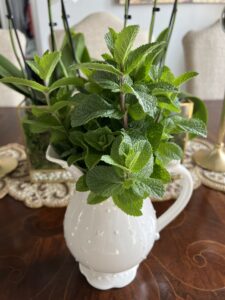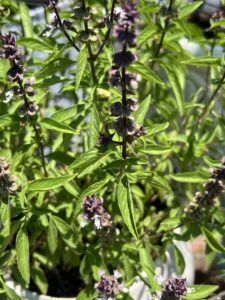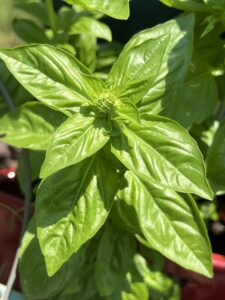
Herbs are a vital element in the preparation of plant-based meals as they provide a variety of complex flavor notes and undertones, they significantly enhance the taste of a meal without adding a lot of salt and they can be easily dried and stored for extended use. Additionally, herbs are excellent sources of macro and micronutrients, which becomes the perfect supplement for a balanced plant-based diet. Further, a large population of herbs are high in medicinal value and provides healing not only to the body but also to the soul and mind as well! Having herbs as crop options, in a home garden, will also provide a healthy balance in the soil and ward off harmful pests that may potentially destroy your garden crops.
Being able to plant and cultivate herbs can be a simple and effortless task. They are easy to find year-round, they thrive indoors and outdoors, they are low maintenance high-yield crops, they can grow and be maintained with minimal sunlight and limited space and simple mediums, such as water, can be used to propagate them and maintain them for extended periods of time.
If you are intimidated or overwhelmed by the thought of starting a full-blown vegetable garden, dabbling with a small herb garden will be the perfect way to get your hands dirty and build confidence before moving on to the larger task. There is a wide variety of herbs that one can choose from depending on the desired look of your garden and the expected taste needed for dishes that you plan to prepare in the future. Let us explore a few popular options of the many herb choices available.
Basil is a low maintenance herb that can be grown in a container, garden bed or even in water. There is a large variety of basil herbs, with the most popular varieties being sweet basil and Thai basil. Basil is often utilized in a variety of Italian dishes, Thai dishes, salads, and is usually one of the key ingredients in a traditional Italian pesto. This aromatic herb can be consumed raw and is high in vitamin K. It is a known remedy for bug bites, nausea and is a natural antibiotic that also prevents the formation of ulcers.
Basil tends to grow in warmer seasons when temperatures are above 60 0C (140 0F). Basil should be watered generously without over watering to prevent wet, water-logged roots. This herb tends to grow tall and narrow and produces spikey flowers very quickly. To promote branching of the herb and for a fuller look, the plant should be pruned weekly. If planted in the soil, compost should be added around the base of the plant to feed with the required nutrients. Early production of flowers in the basil plant typically signifies that the plant is stressed and signals that the plant is not growing in the most optimal conditions.
Cilantro is a herb that is typically utilized in many Mexican and Indian dishes. The most popular being salsas and chutneys. I love using cilantro in just about every meal I prepare, especially in soups and stews. Its lemony and peppery flavor profiles give it its flexibility as a key ingredient in a variety of dishes. Almost every part of the cilantro plant in used in cooking including the seeds, which are known as coriander seeds. Cilantro is rich in vitamins A, C and K and is also a source for folate, potassium, and manganese. It’s a known antibiotic and has the potential to lower blood sugar levels in diabetics.
Growing cilantro can pose a few challenges. It is one of the few herbs that can be a little tricky to grow. It tends to bolt (that is the stems become thicker, the leaves change their shape and the flowers produced are tiny, in preparation for seed production), flower and seed very quickly if it is not being grown in ideal conditions. Cilantro thrives best in cooler seasons and should be planted right after frost has passed. For best results, cilantro seeds should be sown directly into ground to reduce the plant from being moved around. Disruption of its delicate tap root system can cause stress to the plant. The leaves of the cilantro herb should be harvested regularly to keep the plant healthy and encourage leaf production. When growing cilantro, plant next to taller plants that can provide shade to the herb and soil, making its local environment cooler. Cilantro needs four to six hours of sunlight for optimal growth. Planting cilantro seeds weekly will ensure a continuous supply of this flavorful garden herb during the growing season. At any given time, not more than one third of one plant should be harvested to promote a healthy plant.
Thyme is a nutritious herb that grows well in most seasons. It’s very hardy and has a shallow root system that makes it ideal for growing in containers that has well drained soil. Its tiny, fragrant flowers make the thyme plant very attractive to bees and other pollinators and so it is an asset to a garden that has other fruiting plants that require pollination, such as squashes, cucumbers, and tomatoes. There are about 14 varieties of thyme herbs that each presents its own unique flavor profile, which ranges from earthy to mildly citrus. The most common thyme varieties include English thyme, lemon thyme, lavender thyme and Italian Oregano thyme. Each of these varieties can be distinguished based on the color of the flowers produced, the leaves and the aromaticity.
Due to its distinctive taste and flavor profile, thyme has been a culinary staple for centuries and is still used today in a variety of dishes that spans diverse ethnic cultures. In addition to its bold flavor, thyme is packed with a host of nutrients including vitamins A and C, copper, fiber, iron, and manganese. It also boasts a slew of health and wellness benefits which include lowering blood pressure, boosting immunity, alleviating coughs, treating yeast and bacterial infections and repelling insects.
Mint is a popular herb used in both food and drink dishes alike. There are several varieties of mint with the most common being peppermint, spearmint, chocolate mint and sweet mint. Typically, spearmint is used in savory dishes, peppermint in sweet dishes and sweet mint in teas in specialty drinks. Mint is a prolific growing herb and if not managed properly can take over an entire garden within a few growing seasons. The best way to grow mint is by itself! Growing different varieties of mint herbs side by side can cause them to lose their distinct aroma and flavor. The mint plant prefers sandy, well-drained soil and lots of sun light.
Traditionally, both peppermint and spearmint have long been used of their medicinal properties for aiding in digestion, alleviating a host of gastrointestinal issues and relieving nasal congestion and flu symptoms. The larger mint varieties also have a plethora of health benefits which include relieving pain, tension headaches, improving brain function, dental health and serving as an antibiotic. Mint is also nutrient rich and contains vitamins A and C, potassium, iron, phosphorous, calcium, and magnesium.
Oregano is an earthy herb used in many Italian and Mexican style dishes and is one of the prominent ingredients used in making pizza sauces. Oregano is high in antioxidants, dietary fiber, folates, iron, manganese, carotene and vitamins A, C and K. Typically referred to as a super food because of its rich nutrient content, oregano also boasts a host of health benefits. It’s high fiber content helps to control blood cholesterol levels. The variety of essential oils found in oregano such as thymol, limonene and carvacrol makes the herb a good antibacterial and antifungal agent and best for treating indigestion, mild fever, and pain.
Oregano is hardy, spreads quickly and is a relatively low maintenance herb. It is classified as a perennial plant, is self-seeding and will therefore return for subsequent growing seasons even after harsh winters. It thrives best in hot dry climates, with full sun and sandy, well-drained soil. Oregano is easily propagated from cuttings from a healthy, established plant and should be harvested frequently by pruning to encourage new leaf growth and a fuller plant. Plants should be watered at the base only when the soil feels dry. Overwatering should be avoided to prevent diseases. The best time to harvest oregano is right before it blooms. This is when the flavor is most intense in the leaves and the leaves also prime for drying.
Herbs add diversity and flavor to your garden and plant-based dishes, while providing required nutrient supplements and health and wellness benefits. Learning how to successfully grow and harvest these ancient wonders will enhance your gardening experience as your reward will be quick and bountiful and your cooking experience as the taste of the meals you prepare will be palatable to many.


Previously published on the Monitortribune.com on June 25, 2024.
